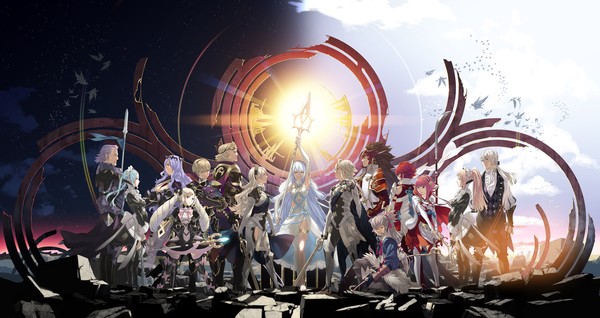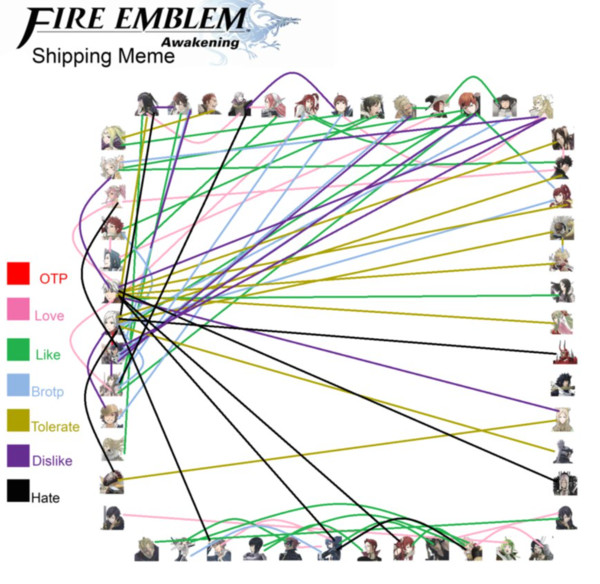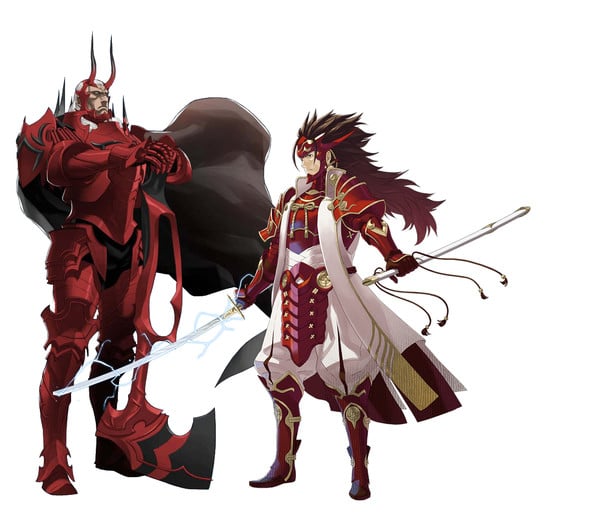How Fire Emblem Became a Phenomenon
by Gabriella Ekens,For the longest time, Fire Emblem stood alongside Earthbound as one of those Nintendo franchises people primarily knew from Super Smash Bros. That all changed in 2013, when Fire Emblem: Awakening came out on the 3DS to instant popularity. Despite some more minor past succcesses on GBA and Gamecube, Awakening's release seemed to singlehandedly create a Fire Emblem fandom that hadn't previously existed with such passion outside of Japan. As a fan of the series since childhood, I was actively following the development of this new game long before it came out, and everything I read about it screamed to me that Awakening was going to satisfy something I had always wanted out of Fire Emblem. You see, they were bringing back one of the franchise's most beloved, discarded features – the character pairing and child-rearing mechanic. When Awakening actually came out, I was satisfied beyond my wildest dreams. So how did Awakening change the franchise so radically while still appeasing an uber-fan like me? Are the 3DS games really a radical departure for the franchise? The answers all lie in in the dark past of 1994...

But before we revisit that landmark year for the franchise, you might need a brief overview of how we got all the way to FE: Fates in the first place. Although the first Fire Emblem game debuted in 1990, the series only arrived stateside in 2003 with its seventh entry, Rekka no Ken. The next four games were marginally successful overseas, but sales dwindled over time. The unpopular twelfth installment never even arrived in the West. By 2010, things looked bleak for the series. The thirteenth game, Awakening was intended to cap things off. Wanting to go out with a bang, the team made it a distant sequel to the first few games (the ones actually starring Marth) and implemented all of the features they'd dreamed of putting in, but were never able to execute before. The result was a totally revamped art style, improved combat, and a new mix-and-match support system. Blending the historical aspects of Fire Emblem with modern anime sensibilities seemed like the perfect way to send off the franchise, but fate had one final twist in store for the team. Awakening was a massive success – it sold more than three times as much as the previous globally released Fire Emblem. For the first time in years, Fire Emblem was in demand, and the team that intended Awakening to be their final game was commissioned for a lavish new sequel – Fire Emblem: Fates.

This brings us back to 1994, when the fourth Fire Emblem game was released: GENEALOGY OF THE HOLY WAR. Now considered one of the best, it contained an unusual number of anomalous features for the series, like huge maps and a relatively small number of chapters. It's still a great game that's especially worth taking a look at if you're interested in the franchise's history, and its defining feature was the "support system." Rather than continuing the trend of fairly limited and unimportant side conversations that constitute supports in other games, pretty much any male and female character in Genealogy can get married and produce a child. This was all just build-up to a climactic event – when all of your units die and you need to beat the rest of the game with their kids! All that matchmaking was intended to breed brats with the necessary stats to take down the evil empire and avenge their parents. Despite being a beloved mechanic, this system was abandoned in the series until Awakening, when it was brought back in a modified form. In the vast majority of Fire Emblem games, supports were just bonds you cultivated between a limited number of characters for stat bonuses. If you were lucky, they unlocked cutscenes.Still, they were a side feature and not all that easy to get – I recall many trips through the Tower of Valni in Sacred Stones to grind characters up to A rank.
Genealogy of the Holy War also introduced a more dubious Fire Emblem tradition: brother/sister incest. It's a motif throughout the series that Fates embraced wholeheartedly. But while that game treats the option to marry your (ADOPTED) siblings as a selling point, Genealogy used it as the centerpiece to a tragedy: a brother and sister with recessive evil genes are tricked into marrying so that their child can be the vessel for a dark dragon god.

It's ironic that modern Fire Emblem games are most indebted to Genealogy – in terms of story, they couldn't be more different. Awakening is poppy, fun, and largely comedic in tone. Genealogy, by contrast, is often somber and disturbing. While there's a tragic backstory hiding behind Awakening's main timeline, you can get through the playable story with everyone alive and happy. The same can't be said for Genealogy, where the entire cast of the first half is inevitably captured and executed by the enemy.Despite his noble intentions, the hero's actions only factored into the villain's plot. His son, Seliph, has to undo his father's mistakes in order to topple the evil dragon emperor. It's not a unique story, but this sort of operatic tragedy was largely scrubbed out of Awakening. It reappears in Fates, but even there, you have the option to avoid loss. Sure, you have to annihilate half of your family in either Birthright or Conquest, but Revelations gives you the option to save EVERYBODY – and then throw a beach party! It looks like we won't get any more Fire Emblems that don't give you the option to save everyone and everything, but that's not necessarily a bad thing.
One of my favorite things about Fire Emblem is how the series innovates so consistently while remaining informed by its own history. Much like the Final Fantasy series, the gameplay differs significantly in each installment. Over the years, Fire Emblem has become adept at paying homage to its past while reinventing itself to draw in a changing audience. So Awakening (and now Fates) took a fan-favorite mechanic from the series' darkest entry and repurposed it into something that made it inviting again. Everything changed by making this gimmick empowering (you can pick whichever imaginary husband/wife you want) rather than disempowering (the units you spent dozens of hours cultivating are now dead, now here are their spawn). This change rode the tide of a modern gamer and anime fan culture that favors indulgence, immersion, and customization. Players were already going to come up with theories about which characters should kiss and why, so why not just build that into the game? Thus, both lighthearted jokes and semi-serious matchmaking were blended together to create a system where you can SHIP YOURSELF SILLY.

The support system has been a Fire Emblem staple since near the beginning, but no previous entry has handled it as comprehensively as these new 3DS games. First of all, one character's supports are no longer limited to a handful of arbitrarily selected other characters. Rather, they've been expanded to nearly everyone of the opposite sex, and almost all mixed-sex pairings can be romantic. You could hook up pretty much any guy with any girl, and it would affect gameplay in the form of bonuses and a child's stats. Your carefully-selected couples will have babies that you raise to fight for your army with stats and class options that reflect their parents. In terms of pure mechanics, it's a min-maxer's paradise.
Of course, stats aren't the only thing that matters on the soldier farm. Each couple has unique “support conversations” that allow you to see how they get along with their potential breeding partner. While they all end up falling in love by the end, support convos reveal a couple's dynamic. Players can choose who they want based on their own romantic values, creating an incredibly satisfying, personalized experience. In Awakening, you can give Lord Chrom a childhood friend romance with tomboy knight Sully, or make him fall in love at first sight with the foreign dancer Olivia. You can also claim him yourself, becoming his queen.
It's no coincidence that this game was also one of the first to include a player avatar. Via your customizable self-insert (who is, of course, a mysterious amnesiac chosen one) you can get with any of the characters, even the ones that aren't normally up for marriage. These characters span a vast array of anime fetishes, from your run-of-the-mill tsundere to bunny people to enormous warlord lobster-men.

There's a constant tension between which pairings you might like best and which will produce the best stats. There's an addictive quality to balancing these factors – I've spent a frankly embarrasing amount of time debating who should get with who in my various playthroughs. "Virion and Sully are the cutest together," I would argue, "but archer is a bad reclass option for Kjelle. Gregor/Nowi makes for a strong Nah, but I'm concerned about the age difference there. Henry and Sumia would be cute, but then who am I going to marry off to Lissa…" I have entire excel documents of this nonsense, and I can prove it.

The expanded support system was a ton of work. Fire Emblem games aren't known for their wordcounts – your average unit will be lucky to have more than one joint dialogue and a death quote in the story campaign. Each single game will have dozens of characters, so four skits per male/female pair is a lot to add. This type of development definitely didn't factor into earlier Fire Emblems, where characters often amounted to Guy With Axe, his twin brother, Other Guy with Axe, and Guy Whose Name is Guard Spelled Backwards.

Because of this, Fire Emblem had to substantially improve its characterization per unit. My experience with Fates so far has been punctuated by many entertaining, funny, and even genuinely touching character interactions. My favorite character is Rhajat, Hayato's child with a striking resemblance to Awakening's Tharja. While I found Tharja to be a somewhat cliché stalker chick, her reincarnation in Rhajat has done a lot to redeem the character, making her out as an awkwardly brooding but ultimately well-meaning mall goth. Via their supports, her mother realizes that her daughter's dark proclivities don't make her evil, and the two come to terms regarding her father's extended abscences in her life. Beyond that, every single interaction she's had with another character has left me laughing out loud at least once.
This all culminates in a fairly nuanced portrait of an individual, and I was quite attached to Rhajat by the end, even though she's ultimately a pawn in a giant game of chess. It really hurts to make an enemy of her parents in Conquest.

So Fire Emblem made something that fans would inevitably do – ship characters – into a game mechanic, and your own self-insert has the first choice. It was not only a brilliant move, it was the #1 thing that revitalized interest in the franchise (in my opinion), along with new FE's totally revamped aesthetic. Fire Emblem has gone through a number of art styles thorughout the years, but throughout its “dark period” of waning popularity, it went for a more pseudo-realistic style, with characters that looked like lumpy claymation dolls. While Fire Emblem has always had impressive sprite work, the look of these games is more “Crusader Kings 2” than “Nintendo handheld title.” By contrast, Awakening and Fates go in the absolute opposite direction of being anime as all hell. Do you want maids and butlers? Well, Fates has maids and butlers! Do you want your imouto to call you onii-san or onii-chan? Then choose between the PATH OF HOSHIDO and PATH OF NOHR. Ninjas? Check. Kemonomimi? Check. Scenes where the joke is that a woman can't cook? Check-check-checkeroo. The only thing more anime than modern Fire Emblem is the Shin Megami Tensei/Fire Emblem crossover Tokyo Mirage Sessions ♯FE, which is like overdosing on the distilled essence of Akihabara.

In many ways, Fire Emblem is the ideal long-running series for me. It's constantly experimental, keeping up with the times while also remaining aware of what people liked in previous games, and Fates is the ideal synthesis of those decades of experimentation. Rather than the minimal differences I've come to expect out of split version games (looking at you, Pokemon) Birthright, Conquest, and Revelations are all vastly different experiences that represent different versions of the franchise. Birthright is an Awakening-esque newbie-friendly grindfest, while Conquest is a classic limited-resources puzzlebox, and Revelations incorporates some area gimmicks into a fully realized melodramatic fantasy story. I love Fire Emblem games both new and old, and I'm excited to see a new audience discover the series now.

So when did you get into Fire Emblem? Which one is your favorite, and what do you think of the shipping mechanic? And of course, did you go the path of Hoshido or the path of Nohr?
discuss this in the forum (79 posts) |